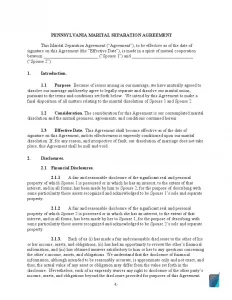Pennsylvania Marital Settlement (Divorce) Agreement and Legal Separation
As is revealed in Pennsylvania divorce statistical data, the state’s residents who terminate their marriages have chosen divorce less often since the beginning of the century; however, sometimes, a divorce is inevitable. If the spouses have peacefully agreed to end their marriage, it is wise and legally necessary to sign the Pennsylvania Marital Settlement Agreement. This legal paper contains information about the spouses’ post-marital interaction.
The fillable marital settlement agreement form is a fundamental instrument for couples who possess common property or have children together. Once the spouses have completed the document, each party has to review the information they have agreed upon and append their signatures. The paper requires notarization to be rendered legally binding. To acquire the most recent customized template, we recommend using our form-building software.

Build Your Document
Answer a few simple questions to make your document in minutes
Save and Print
Save progress and finish on any device, download and print anytime
Sign and Use
Your valid, lawyer-approved document is ready
Pennsylvania Divorce and Separation Laws
The government does its best to prevent families from splitting up. The laws and requirements presented below are developed for spouses to understand what they can expect from the procedure.
Grounds for Divorce
Lawful grounds for divorce are described in Title 23, Chapter 33, Section § 3301 of the Pennsylvania state law. Generally, these grounds are categorized into Fault and No-Fault. Faults include cheating, unacceptable behavior, addictions, abuse, etc.
Property Division
Undoubtedly, one of the most complicated issues is sharing real estate and personal property, especially if the spouses did not protect themselves by signing a marital contract at the beginning of their marriage. Division of property is implemented according to Title 23, Chapter 35, Section § 3502 of the Pennsylvania law. All property—real or personal—is considered marital if it was acquired during the couple’s marriage. The court may impose a lien on an alimony payer to prevent them from avoiding this liability. The court can also orderer a spouse to reside on the marital property.
Child Custody and Visitation
If the married couple had children, solving kids-related problems becomes a top priority. Usually, children are the ones who suffer after the end of their parents’ relationship.
In Pennsylvania, custody over a child depends on their own choice, their parent’s readiness to interact, and a domestic abuse or neglect history. The court possesses a legal right to order joint or single-parent custody. Still, it will always favor co-parenting and enough quality time for the minor(s) and both parents where possible.
A child may demand visitation as a part of an open divorce, which will be arranged in their best interests depending on their relationship with siblings and other family members, the efficiency of communication with a separately-living parent, parental preferences, and a history of domestic violence.
Typically, the child can see the other parent and their new family as often as they desire if there are no restricting circumstances.
Child Support and Alimony
Title 23, Chapter 37, Section § 3701 regulates this issue in the state. Alimony is allowed depending on whether the court considers it reasonable. The court will establish (if found necessary) the duration of the order. If the couple gets remarried over time, the alimony will be automatically revoked. In case either the payee or the payer dies, alimony payments shall cease unless otherwise indicated in their agreement.
Popular Local Marital Settlement Agreement Forms
It’s wise to spell out the provisions of your divorce ahead of the case hearing by drafting a marital settlement agreement that addresses a range of issues. Listed below are some of the most frequently searched documents for divorce settlement by state.
Legal Separation
In Pennsylvania, Legal separation—a situation that implies living in different households while remaining spouses—is not recognized by the state law. A couple wishing to separate legally can opt for a private agreement, which serves the same functions in other states. If you decide to terminate the marriage in the end, you can always change your private agreement to a divorce.
There is an alternative—an annulment— that terminates a marriage like a regular divorce but also claims your relationship void or invalid.
To file for an annulment in Pennsylvania, one will have to prove at least one of the following, among other grounds, to be true:
- Bigamous or a polygamous marriage
- Marrying a person who was younger than 18 years of age
- Marrying a close relative
- One of the spouses’ mental inadequacy

Filing for Divorce in Pennsylvania
If you and your spouse have signed a Pennsylvania Marital Settlement Agreement, the procedure will be less stressful and complicated.
No couple gets married planning to divorce later. However, different circumstances can lead to separation, which is no big deal in the modern world. In this section, you will get acquainted with the steps to take after deciding to dissolve their marriage.
1. Prepare the Required Documents
A marriage is usually terminated due to one of the spouses’ legal faults. A spouse can file for a divorce if the couple has been living apart for a year. Even if the divorce process is amicable, the plaintiff and the respondent should appear in court, and one of the spouses has to initiate this procedure. In Pennsylvania, one of the married spouses (or both) has to be dwelling in this state for at least six consecutive months to file for divorce legally.
2. Go to Court
Family issues are dealt with in the Court of Common Pleas. Choose the one closest to your residency to file for divorce. Make sure you have paid applicable fees, which vary from county to county ($125-$300).
3. Deliver the Papers to the Adverse Party
Once you have prepared a complaint and other required divorce-related papers, you have to hand them over to the respondent. The other party should accept these papers for the divorce process to move forth.
4. Disclose Finance-Related Materials
Ensure that you attach your loan disclosure, credit card records, and other relevant information. When the divorce is based on mutual consent, the couple can resolve financial issues before going to court—themselves or through a mediator. Such precautions will make the process much simpler.
5. Receive a Divorce Certificate
The spouses should sign an Affidavit of Consent 90 days after the initial filing, signed and dated by both parties, implying that no one has changed their mind about ending the marriage. You will be asked to sign and provide some more papers, which the court will consider before making a decision.
If a couple experiences difficulties keeping the process amicable, they can seek competent assistants’ mediation and support. Once the divorce has been initiated, the couple has to wait for at least three months before the court makes a decision. Persons are allowed to get married again right after their divorce.

Use our document maker to customize any form offered on our website to your requirements. Here is a range of some other printable Pennsylvania forms we offer.
Other Marital Settlement Agreement Forms by State